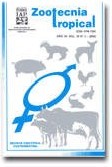
|
Zootecnia Tropical
Instituto Nacional de Investigaciones Agrícolas Venezuela
ISSN: 0798-7269
Vol. 29, No. 1, 2011, pp. 103-112
|
 Bioline Code: zt11009
Bioline Code: zt11009
Full paper language: English
Document type: Research Article
Document available free of charge
|
|
|
Zootecnia Tropical, Vol. 29, No. 1, 2011, pp. 103-112
| es |
Producción y composición química de forrajes de dos especies de pasto Elefante ( Pennisetum  sp.) en el Noroccidente de Venezuela sp.) en el Noroccidente de Venezuela
González, Ignacio; Betancourt, María; Fuenmayor, Abdénago & Lugo, María
Resumen
El objetivo de la investigación fue evaluar el efecto del cultivar y la edad de madurez o cosecha sobre la
composición química y el rendimiento en dos especies de pasto elefante Pennisetum

sp. (verde y morado), en
condiciones de bosque muy seco tropical del Occidente de Venezuela. El experimento se realizó en un área
cultivada de aproximadamente 1 año de establecida, sembrada en hileras a 1,00 m de separación, sobre la cual se
seleccionó un área experimental de 1.170 m 2 (90 x 13) para la investigación. El diseño experimental utilizado fue
completamente aleatorizado, con arreglo factorial 5 x 2, 2 cultivares y 5 edades de madurez o cosecha (14, 28, 42,
56 y 70) días, repetidos 3 veces, para medir su efecto sobre las variables materia parcialmente seca (MS), proteína
bruta (PB), fibra neutra detergente (FND), fibra ácido detergente (FAD), lignina ácido detergente (LAD), ceniza
(CZ), rendimiento de materia verde (RMV) y rendimiento de materia seca (RMS). Se observó alta potencialidad
de producción de biomasa para ambos cultivares, resultando superior (P <0,01) el cultivar elefante verde con
rendimientos promedios de 10,2 t/ha MS, mientras que los mejores valores (17,1 %) de PB fueron aportados por
el cultivar elefante morado. Solo hubo respuesta para FND con valores de 55,7 % para el cultivar Elefante verde.
Los parámetros de composición química y rendimiento aumentaron con la edad de madurez, mientras que los
contenidos de proteína y ceniza disminuyeron. El pasto Elefante ( Pennisetum

sp) como pasto de corte, muestra
un alto potencial para la producción y calidad de biomasa, sin embargo como cualquier otro pasto tropical, reduce
su valor nutritivo con la edad de madurez, lo cual requiere del establecimiento de estrategias de manejo para su
eficiente utilización durante el año.
forraje, Pennisetun sp., composición química, rendimiento
|
| |
| en |
Production and chemical composition of forages de dos species of grass Elephant ( Pennisetum  sp.) in Noroccidente de Venezuela sp.) in Noroccidente de Venezuela
González, Ignacio; Betancourt, María; Fuenmayor, Abdénago & Lugo, María
Abstract
The objective of the investigation was to evaluate the effect of cultivar and the age of maturity or harvest on the
chemical composition and the yield in two species of Grass elephant Pennisetum

sp. (Green and Purple), under
conditions of very dry tropical forest West of Venezuela. The experiment was carried out in a cultivated area of
approximately one year of established, sowed in arrays to 1,00 m of separation, of which an experimental area
of 1.170 m 2 (90 x 13) was selected, for the investigation. The experimental design was factorial 5 x 2, with 2
cultivars and 5 ages of maturity or it harvests (14, 28, 42, 56 and 70) days, with three repetitions, to measure
its effect on the partially dry matter variable (MS), gross protein (PB), fiber neutral detergent (FND), fiber acid
detergent (FAD), lignina acid detergent (LAD), ash (CZ), yield of green matter (RMV) and yield of dry matter
(RMS). High potentiality of production of biomass was observed for both cultivars, of which cultivating green
elephant resulted superior with a (P <0,01) cultivating green elephant with yields averages of 10,2 t/ha MS, while the best values (17,1%) in PB were contributed by cultivating lived elephant. For the components alone cellular
wall there was answer for FND with values of 55,7% for cultivating green elephant. The parameters of chemical
composition and yield increased with the age of maturity, while the protein contents and ash diminished. The
grass elephant ( Pennisetum sp) like court grass, show a high potential for the production and quality of biomass,
however as any tropical grass, it reduces their nutritious value with the age of maturity, that which requires of the
establishment of handling strategies for their efficient use during the year.
forage, Pennisetun sp., chemical composition, yield
|
| |
© Copyright 2011 - Zootecnia Tropical
Alternative site location: http://www.sian.inia.gob.ve/repositorio/revistas_ci/ZootecniaTropical/ztindice.htm
|
|
